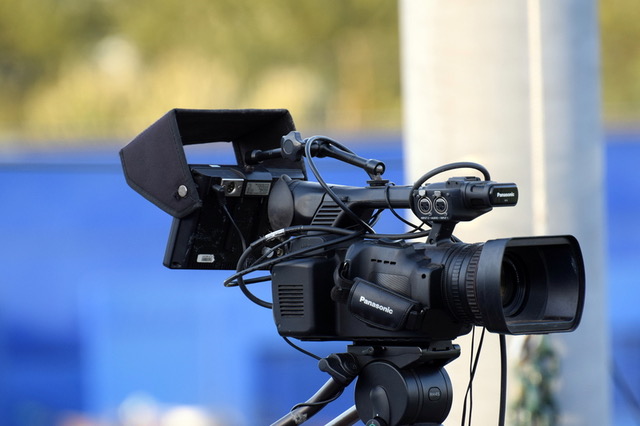-
 Crude sinks as Trump delays decision on Iran strike
Crude sinks as Trump delays decision on Iran strike
-
Two dead in Mexico as Hurricane Erick moves on from Mexican coast

-
 US appeals court allows Trump control of National Guard in LA
US appeals court allows Trump control of National Guard in LA
-
Monsters and memes: Labubu dolls ride China soft-power wave

-
 Chad hopes 'green charcoal' can save vanishing forests
Chad hopes 'green charcoal' can save vanishing forests
-
'Turkish salmon': the Black Sea's new rose-coloured gold

-
 Rays pitcher Bigge hospitalized after being struck by foul ball
Rays pitcher Bigge hospitalized after being struck by foul ball
-
PSG stunned by Botafogo after Messi lights up Club World Cup

-
 Thunder ready to play for all the marbles - Gilgeous-Alexander
Thunder ready to play for all the marbles - Gilgeous-Alexander
-
Europe's lithium quest hampered by China and lack of cash

-
 Japan-US-Philippines hold coast guard drills with eye on China
Japan-US-Philippines hold coast guard drills with eye on China
-
Richards strike gives USA spot in Gold Cup quarters

-
 Pacers thrash Thunder to stay alive in NBA Finals
Pacers thrash Thunder to stay alive in NBA Finals
-
Cheap alms bowls imports hit Sri Lanka makers, monks

-
 Pacers demolish Thunder to stay alive in NBA Finals
Pacers demolish Thunder to stay alive in NBA Finals
-
PSG stunned by Botafogo in Club World Cup upset

-
 Peru gas workers find thousand-year-old mummy
Peru gas workers find thousand-year-old mummy
-
UK MPs to hold crunch vote on assisted dying

-
 Australian trial says tech for social media teen ban can work
Australian trial says tech for social media teen ban can work
-
Thai PM to meet army commander to defuse political crisis

-
 Rice prices double in Japan as inflation accelerates
Rice prices double in Japan as inflation accelerates
-
Summoning golden Olympic memories, Paris parties like it's 2024

-
 Peru's Maido named world's top restaurant on 50 Best list
Peru's Maido named world's top restaurant on 50 Best list
-
US singer Chris Brown in London court on assault case

-
 Thailand credits prey releases for 'extraordinary' tiger recovery
Thailand credits prey releases for 'extraordinary' tiger recovery
-
Can NATO keep Trump on-message about Russia threat?

-
 Australia drop struggling Labuschagne for first West Indies Test
Australia drop struggling Labuschagne for first West Indies Test
-
European, Iranian diplomats to meet as US mulls joining Israel campaign

-
 Paris makes clean water bet for River Seine bathers
Paris makes clean water bet for River Seine bathers
-
Jeeno Thitikul edges clear as heat takes toll at Women's PGA

-
 Critic of Nicaragua's Ortega shot dead in exile in Costa Rica
Critic of Nicaragua's Ortega shot dead in exile in Costa Rica
-
Barrios double gets Atletico back on track

-
 Alpha Growth PLC - Providence Life Granted Isle of Man Branch License
Alpha Growth PLC - Providence Life Granted Isle of Man Branch License
-
Relief Therapeutics Receives FDA Response to QIDP Request for RLF-TD011

-
 World No. 1 Scheffler shares lead at PGA Travelers Championship
World No. 1 Scheffler shares lead at PGA Travelers Championship
-
Messi's 'winning spirit' surprising: Inter Miami's Mascherano

-
 US immigration agents barred from LA Dodgers' stadium: team
US immigration agents barred from LA Dodgers' stadium: team
-
SpaceX Starship explodes on Texas launch pad

-
 Messi strikes as Inter Miami stun Porto at Club World Cup
Messi strikes as Inter Miami stun Porto at Club World Cup
-
US immigration agents barred from LA baseball stadium: team

-
 Jorginho gunning for old side Chelsea with Flamengo at Club World Cup
Jorginho gunning for old side Chelsea with Flamengo at Club World Cup
-
Real Madrid star Mbappe released from hospital

-
 World No.1 Sinner shocked in Halle second round by Bublik
World No.1 Sinner shocked in Halle second round by Bublik
-
Chelsea boss Maresca 'trusts' Mudryk after doping charge

-
 Israel welcomes 'all help' in striking Iran, Trump to decide 'within two weeks'
Israel welcomes 'all help' in striking Iran, Trump to decide 'within two weeks'
-
Zverev holds off Sonego to reach Halle quarter-finals

-
 Palmeiras ease past Al Ahly in Club World Cup
Palmeiras ease past Al Ahly in Club World Cup
-
Alcaraz survives scare to reach Queen's quarter-finals

-
 Stokes adamant Archer 'desperate' for England return
Stokes adamant Archer 'desperate' for England return
-
Palmeiras v Al Ahly Club World Cup clash suspended for weather

Iran's Ayatollahs the next to Fall?
Following the collapse of the Assad regime in Syria and the ascent of Hay’at Tahrir al-Sham (HTS) to power, questions are emerging about the broader regional impact of this seismic shift. One of the most debated scenarios is whether Iran—long an influential player in Syria—could soon face its own regime-shaking upheaval. Could the Islamic Republic’s Ayatollah be next in line to lose his grip on power?
Iran’s Deep Involvement in Syria
Iran has been a steadfast supporter of the former Assad government, providing military advisors, financing, and strategic counsel. For years, Iranian-backed militias played a critical role in propping up the Syrian regime against a multitude of opposition forces. With Assad’s fall, Tehran finds itself facing a new power structure in Damascus—one led by a group previously hostile to both the regime and its foreign backers.
Reduced Regional Influence
The loss of Assad may weaken Iran’s leverage in the Levant, limiting its ability to exert pressure on neighboring countries. A more extremist government in Damascus could seek to push out or marginalize Iranian influence to consolidate its own standing.
Strategic Setback
Iran’s “Shia Crescent” strategy, which sought to create a corridor of allied governments stretching from Tehran to the Mediterranean, appears severely compromised. This setback may embolden Iran’s adversaries at home and abroad, fueling the notion that Tehran’s regime could be similarly vulnerable.
Domestic Pressures in Iran
Even before events in Syria escalated, Iran’s leadership faced growing internal discontent. Public frustration with economic hardships, alleged corruption, and strict social controls has been an undercurrent for years, occasionally erupting into protests.
Economic Challenges
International sanctions have strained Iran’s economy. Unemployment and inflation add to widespread dissatisfaction, weakening the regime’s domestic legitimacy.
Protest Movements
Periodic demonstrations, sometimes met with harsh crackdowns, reveal a restive population demanding reforms. Younger Iranians, especially urban and educated demographics, often use social media to organize protests and call for greater freedoms.
Leadership Questions
Ayatollah Ali Khamenei’s advanced age has sparked debates about succession. Hardline factions and moderate reformists remain divided, raising the possibility of political instability if the supreme leader’s authority wavers.
Could HTS’s Victory Inspire Iranian Opposition?
The question many observers are asking: if a once-fringe, hardline group like HTS can topple a long-entrenched regime in Syria, might Iran’s leadership be more vulnerable than it appears?
Symbolic Resonance
Zhe collapse of Assad—a key ally—damages Tehran’s image of regional ascendancy. Opposition groups in Iran may see HTS’s triumph as a sign that even the most entrenched regimes can crumble under the right conditions.
Geopolitical Shifts
Regional players opposed to Iran’s influence may feel emboldened and offer covert support to Iranian dissidents. A shift in Damascus could reduce Tehran’s ability to move personnel, weapons, or resources across Syria, weakening its strategic depth.
Counterarguments: Why Iran May Weather the Storm
Despite these challenges, it is far from certain that Iran’s leadership is on the brink. The Islamic Republic has shown resilience over four decades, surviving international sanctions, internal protests, and regional conflicts.
Security Apparatus
Iran’s Revolutionary Guard Corps (IRGC) remains a potent force, adept at suppressing unrest. A widespread intelligence network monitors opposition activities, often preventing them from gaining traction.
Ideological Cohesion
Many Iranians still identify with the Islamic Republic’s revolutionary ideals. The regime’s ability to rally nationalist sentiment, especially in times of perceived foreign threats, should not be underestimated.
Lack of a Unified Opposition
Multiple opposition groups inside and outside Iran remain fractured, lacking a coherent leadership to mount a credible challenge. HTS’s ascension in Syria may not easily translate into a similar movement within Iran.
Conclusion: A Cautious Outlook
While the unexpected rise of HTS in Syria has undoubtedly rattled long-standing alliances, it is premature to conclude that Iran’s Ayatollah is next in line to lose power. Tehran’s regime, though facing economic challenges and public dissent, still possesses formidable tools of control and a legacy of resilience.
Yet the region’s shifting geopolitics, coupled with growing discontent at home, suggests that Iran’s leadership must navigate increasingly turbulent waters. If the aftermath of Syria’s transformation continues to erode Tehran’s regional standing, domestic opposition could be emboldened—setting the stage for potential change. Whether that will translate into a full-scale power shift remains uncertain, but the seeds of doubt are undeniably taking root.

Saudi Arabia's Economic Crisis

Orban and Putin's Shadow Deal

Ukraine's Drones Bleed Russia

California's Economy: Not Broken

North Korea Infiltrates Economy

Boomers: Selfish or Scapegoats?

Malaysia's Strategic Ascent

Trump’s 50% tariffs on europe

Reverse Apartheid" in SA?

NYALA Digital Asset AG

Trump’s Crackdown: Lives/Risk



